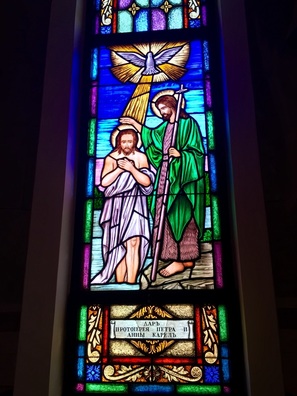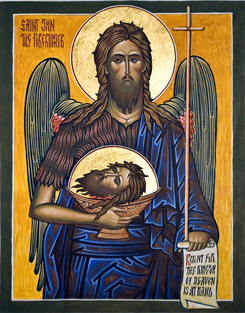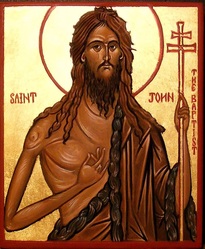Saint John
Prophet, Forerunner, and Baptist of the Lord

"A voice cries: 'In the wilderness prepare the way of the Lord, make straight in the desert a highway for our God. Every valley shall be lifted up, and every mountain and hill will be made low; the uneven ground shall become level, and the rough places a plain. And the glory of the Lord shall be revealed, and all flesh shall see it together, for the mouth of the Lord has spoken,'" (Isaiah 40:3-5) is commonly read as a prophecy of St John.
St John the Baptist who is also referred to as the Forerunner because he came before Christ and prepared the way for Him. He was an ascetic and great prophet, who baptized Christ and became one of the most revered saints in the Orthodox Church.
His father, Holy Prophet Zachariah, was a priest of the course of Abijah (1 Chronicles 24:10), and his mother, Righteous Elizabeth, was of the daughters of Aaron (Luke 1:5). St John held the priesthood of Aaron, giving him the authority to perform baptisms of God.
St John was a cousin of Christ through his mother Elizabeth who was the sister of St Anna, the mother of the Theotokos, both daughters of Zoia. Zoia was the sister of Christ's grandmother.
His birth took place six months before that of Jesus, and according to the Gospel account, was expected by prophecy (Malachi 3:1) and foretold by an angel. Zachariah lost his power of speech because of his unbelief over the birth of his son, and had it restored on the occasion of John's circumcision (Luke 1:64).
St John was a Nazarite from his birth (Numbers 6:1-12; Luke 1:15). He spent his early years in the mountainous tract of Judea lying between Jerusalem and the Dead Sea (Matthew 3:1-12). He led a simple life, wearing rope fiber clothing and eating "locusts and wild honey" (Matthew 3:4).
As an adult St John started to preach in public, and people from every quarter were attracted to his message. The essence of his preaching was the necessity of repentance and turning away from selfish pursuits. He denounced the Sadducees and Pharisees as a "generation of vipers," and warned them not to assume their heritage gave them special privilege (Luke 3:8). He warned tax collectors and soldiers against extortion and plunder. His doctrine and manner of life stirred interest, bringing people from all parts to see him on the banks of the Jordan River. There he baptized thousands unto repentance.
Jesus Christ came to St John to be baptized, in order to "fulfill all righteousness" (Matthew 3:15). John's special office ceased with the baptism of Jesus, who must now "increase" as the King come to His kingdom (John 3:30). He continued, however, for a while to bear testimony to the Messiahship of Jesus. St John pointed Him out to his disciples, saying, "Behold the Lamb of God" (John 1:29, 35).
His public ministry was suddenly brought to a close by his being cast into prison by Herod, whom he had reproved for the sin of having taken to himself the wife of his brother Philip, Herodias (Luke 3:19). He was shut up in the castle of Machaerus, a fortress on the southern extremity of Peraea, 9 miles east of the Dead Sea, and here St John was later beheaded by Herod to satisfy the request of Herod's stepdaughter, Salome, and Herodias (Matthew 14:1-12; Mark 6:14-29). His disciples, having consigned the headless body to the grave, went and told Jesus all that had occurred (Matthew 14:3-12).
Jesus Himself testified regarding John that he was a "burning and a shining light" (John 5:35). St John was the last of the Old Testament prophets, thus serving as a bridge figure between that period of revelation and Jesus. Following his death, St John descended into Hell and there once more preached that Jesus the Messiah was coming.
Because he baptized Christ, St John is considered the patron saint of godparents. He is sometimes called the Angel of the Desert; because of this title, he is sometimes depicted on the icons with the wings.
St John the Baptist who is also referred to as the Forerunner because he came before Christ and prepared the way for Him. He was an ascetic and great prophet, who baptized Christ and became one of the most revered saints in the Orthodox Church.
His father, Holy Prophet Zachariah, was a priest of the course of Abijah (1 Chronicles 24:10), and his mother, Righteous Elizabeth, was of the daughters of Aaron (Luke 1:5). St John held the priesthood of Aaron, giving him the authority to perform baptisms of God.
St John was a cousin of Christ through his mother Elizabeth who was the sister of St Anna, the mother of the Theotokos, both daughters of Zoia. Zoia was the sister of Christ's grandmother.
His birth took place six months before that of Jesus, and according to the Gospel account, was expected by prophecy (Malachi 3:1) and foretold by an angel. Zachariah lost his power of speech because of his unbelief over the birth of his son, and had it restored on the occasion of John's circumcision (Luke 1:64).
St John was a Nazarite from his birth (Numbers 6:1-12; Luke 1:15). He spent his early years in the mountainous tract of Judea lying between Jerusalem and the Dead Sea (Matthew 3:1-12). He led a simple life, wearing rope fiber clothing and eating "locusts and wild honey" (Matthew 3:4).
As an adult St John started to preach in public, and people from every quarter were attracted to his message. The essence of his preaching was the necessity of repentance and turning away from selfish pursuits. He denounced the Sadducees and Pharisees as a "generation of vipers," and warned them not to assume their heritage gave them special privilege (Luke 3:8). He warned tax collectors and soldiers against extortion and plunder. His doctrine and manner of life stirred interest, bringing people from all parts to see him on the banks of the Jordan River. There he baptized thousands unto repentance.
Jesus Christ came to St John to be baptized, in order to "fulfill all righteousness" (Matthew 3:15). John's special office ceased with the baptism of Jesus, who must now "increase" as the King come to His kingdom (John 3:30). He continued, however, for a while to bear testimony to the Messiahship of Jesus. St John pointed Him out to his disciples, saying, "Behold the Lamb of God" (John 1:29, 35).
His public ministry was suddenly brought to a close by his being cast into prison by Herod, whom he had reproved for the sin of having taken to himself the wife of his brother Philip, Herodias (Luke 3:19). He was shut up in the castle of Machaerus, a fortress on the southern extremity of Peraea, 9 miles east of the Dead Sea, and here St John was later beheaded by Herod to satisfy the request of Herod's stepdaughter, Salome, and Herodias (Matthew 14:1-12; Mark 6:14-29). His disciples, having consigned the headless body to the grave, went and told Jesus all that had occurred (Matthew 14:3-12).
Jesus Himself testified regarding John that he was a "burning and a shining light" (John 5:35). St John was the last of the Old Testament prophets, thus serving as a bridge figure between that period of revelation and Jesus. Following his death, St John descended into Hell and there once more preached that Jesus the Messiah was coming.
Because he baptized Christ, St John is considered the patron saint of godparents. He is sometimes called the Angel of the Desert; because of this title, he is sometimes depicted on the icons with the wings.
Why does John the Baptist have wings in Orthodox icons?

September 11th is the day that commemorates the Beheading of St John the Baptist. Why is this Saint, almost uniquely, shown in many icons with wings?
As well as “the Baptist”, St John is also known as “glorious prophet and forerunner of Christ”. Therefore, the presence of the wings is to symbolize John’s status as a divine messenger (in Greek “Evangelos” means both "angel" and "messenger"). It’s worth noting that the wings of the archangels (Gabriel, Michael etc.) in icons are largely symbolic too, as they are not specifically described as having wings in the Scriptures.
But if that were all, then why aren’t the prophets of the Old Testament, or the Apostles, shown with the angelic wings of divine messenger? The answer, in the words of Jesus Christ Himself, is because “among those born of women there is no one greater than John;” moreover, he is “the culmination and the crown of the prophets”, as the hymn from the feast of St John’s nativity proclaims. Therefore, St John is a special example among the Saints of an earthly “angel” and a heavenly man. As such, he is also described as the “Angel of the Desert” in the inscriptions of icons.
The life St John led in the desert was angelic for two reasons. On the one hand he proclaimed the coming of the Messiah, Jesus Christ, becoming a herald of God, like the angels. On the other, he lived a life of chastity, abstinence, and prayer, not being mindful of material needs, but with his attention fixed firmly to heaven. This is the life of the angels, and why the monastic way of life is sometimes called “angelic”, as well as why St John is the patron of monastics, hermits, and ascetics. For both reasons, it is appropriate to show St John with the spiritual wings of a dove.
[Source: A Reader's Guide to Orthodox Icons]
As well as “the Baptist”, St John is also known as “glorious prophet and forerunner of Christ”. Therefore, the presence of the wings is to symbolize John’s status as a divine messenger (in Greek “Evangelos” means both "angel" and "messenger"). It’s worth noting that the wings of the archangels (Gabriel, Michael etc.) in icons are largely symbolic too, as they are not specifically described as having wings in the Scriptures.
But if that were all, then why aren’t the prophets of the Old Testament, or the Apostles, shown with the angelic wings of divine messenger? The answer, in the words of Jesus Christ Himself, is because “among those born of women there is no one greater than John;” moreover, he is “the culmination and the crown of the prophets”, as the hymn from the feast of St John’s nativity proclaims. Therefore, St John is a special example among the Saints of an earthly “angel” and a heavenly man. As such, he is also described as the “Angel of the Desert” in the inscriptions of icons.
The life St John led in the desert was angelic for two reasons. On the one hand he proclaimed the coming of the Messiah, Jesus Christ, becoming a herald of God, like the angels. On the other, he lived a life of chastity, abstinence, and prayer, not being mindful of material needs, but with his attention fixed firmly to heaven. This is the life of the angels, and why the monastic way of life is sometimes called “angelic”, as well as why St John is the patron of monastics, hermits, and ascetics. For both reasons, it is appropriate to show St John with the spiritual wings of a dove.
[Source: A Reader's Guide to Orthodox Icons]
Feast Days
The Orthodox Church remembers Saint John the Baptist on seven separate feast days:
Also, St John's parents Zechariah and Elisabeth, are commemorated on September 18.
- September 11 - The Beheading of St John the Forerunner
- October 6 - Conception of St John the Forerunner
- October 25 - The Russian Orthodox Church observes the Transfer of the Right Hand of the Forerunner from Malta to Gatchina (1799)
- January 20 - The Synaxis of St John the Forerunner (main feast day, immediately after Epiphany on January 19)
- March 8 - First and Second Finding of the Head of St John the Forerunner
- June 7 - Third Finding of the Head of St John the Forerunner
- July 7 - Birth of St John the Forerunner
Also, St John's parents Zechariah and Elisabeth, are commemorated on September 18.
Relics

The First Uncovering of the Head of St John the Baptist took place in the fourth century at the time when St Constantine the Great and his mother, St Helen, began restoring the holy places of Jerusalem.
The Second Finding of the Precious Head of St John the Baptist of took place on on February 18, 452, at Emesa.
After the Seventh Ecumenical Council (787), which reestablished the veneration of icons, the head of St John the Baptist was returned to the Byzantine capital in around the year 850. The Church commemorates this event on June 7 as the Third Finding of the Precious Head of St John the Baptist.
His relics are kept in several places including:
The Second Finding of the Precious Head of St John the Baptist of took place on on February 18, 452, at Emesa.
After the Seventh Ecumenical Council (787), which reestablished the veneration of icons, the head of St John the Baptist was returned to the Byzantine capital in around the year 850. The Church commemorates this event on June 7 as the Third Finding of the Precious Head of St John the Baptist.
His relics are kept in several places including:
- St Demetrios Church, Neo Phaleron, Piraeus
- Benaki Museum, Athens
- Sacred Relics Room, Topkapi Museum, Constantinople (entire right arm and cranium)
- Umayyad Mosque in Damascus, Syria
- Cetinje Monastery, Montenegro (right palm)

